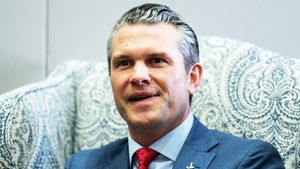It's old news that Abramson is the first female to serve as the executive editor in The New York Times's 160-year history, but it's less known that she's the first person at the top of the masthead to have a New York Times "T" tattoo. In the conversation, Abramson reveals that "T" isn't her only ink, nor is it the only indelible mark a 40-plus year career reporting and editing has had on the New York native's life.
In our interview, Abramson reveals that years after she and her then Wall Street Journal colleague Jane Mayer co-wrote Strange Justice: The Selling of Clarence Thomas, Arlen Specter spoke off the record about the Clarence Thomas and Anita Hill hearing. Abramson seems to suggest that the now deceased Republican Senator regretted some of his statements. Abramson doesn't regret or mince words, however, when it comes to wunderkind Nate Silver walking away from The New York Times, which gave him an invaluable foundation to build his brand. Hear the full interview of Jill Abramson by Catie Lazarus on The Employee of the Month Show's podcast on iTunes.
CL: Where did you feel the most creative in all the different publications you've written for?
Jill Abramson: That's a great question. Obviously the job that I have now as executive editor of The New York Times. You can't beat for creativity. If I get a nutty idea or a creative idea, I can deploy reporters; as long as they think it's a good idea and worthy endeavor to go chase a story. This job is the most creative palate I can think of. It's the equivalent of sitting at the best buffet table in the universe, sampling the sirloin and the lobster or trying to whip up an amazing souffle. There's no beating this one.
When a reporter becomes an editor, I sort of liken it to TV writing when, all of a sudden [when you become a producer,] you're in charge of people even though you've had zero management skills along the way. When you become managing editor and then executive editor, where do you pick up the business skills? Or am I treating that like rocket science?
No, you aren't. I have often paused and wished I could take a month off and go to business school and really study. Actually, my predecessor Bill Keller did that, and I think before him that Howell Raines did that as well. I envy them that they did that. Of course you learn through doing and granular experience just confronting the array of business issues that I do in this job. I wish that I had more expertise.
In this age of brand name journalists, on the one end you have Nate Silver, Ezra Klein, and David Pogue, and they're sort of rock stars in the journalism world. And [then] there are all of these reporters who are just desperate to get paid at all and also don't want to be the star.
There are plenty of people in this newsroom like that.
It's an odd age to be in. I was curious if your negotiations with Nate Silver changed how you look at grooming and mentoring?
Not one bit. I believe more than ever exactly what I said to Nate's lawyer. He represented Nate and [Nate] is this amazing brand and his [lawyer] said to me, "It's like representing the prettiest girl at the party." I looked at him with kind of a raised eyebrow and just in a deadpan voice, I said to him, "I'm very sorry, but The New York Times is always the prettiest girl at the party." I believed that then and I believed that now. I believe that The New York Times will always be an amazing brand and that our political journalism will go on stronger than ever.
What are some of the most absurd or funny letters you've gotten?
The most absurd is after a C-Span appearance a reader, who was in prison, wrote me begging me for a pair of my glasses. I thought that was absurd and slightly ominous.
You have a tattoo of a subway token, I was wondering when you're interviewing someone particularly hip or young do you use it as street cred?
I don't flaunt my tattoos.
Oh wow. You have more than one? So this isn't like a celebrity who wears non-prescription glasses to try and look smart, this isn't a cover to look hip?
It's become for me a strange form of personal hieroglyphics. I have now four. I think eventually, when I finish doing them, will tell the story of me, of where I lived, and what things have been important to me. That doesn't mean that I have my kid's pictures tattooed... I have two then on my back that are the two institutions that I revere, that have shaped me. One is unsurprisingly the amazing 'T' in The New York Times newspaper. Then I have a Crimson Harvard 'H' and that's for Harvard, and also for my husband Henry, who we met when we were in the same class at Harvard. ... And now I feel like shooting myself for spending, like 10 minutes, talking about such a trivial thing.
Catie Lazarus hosts the live show and podcast Employee of the Month.Follow Catie Lazarus on Twitter.








































































